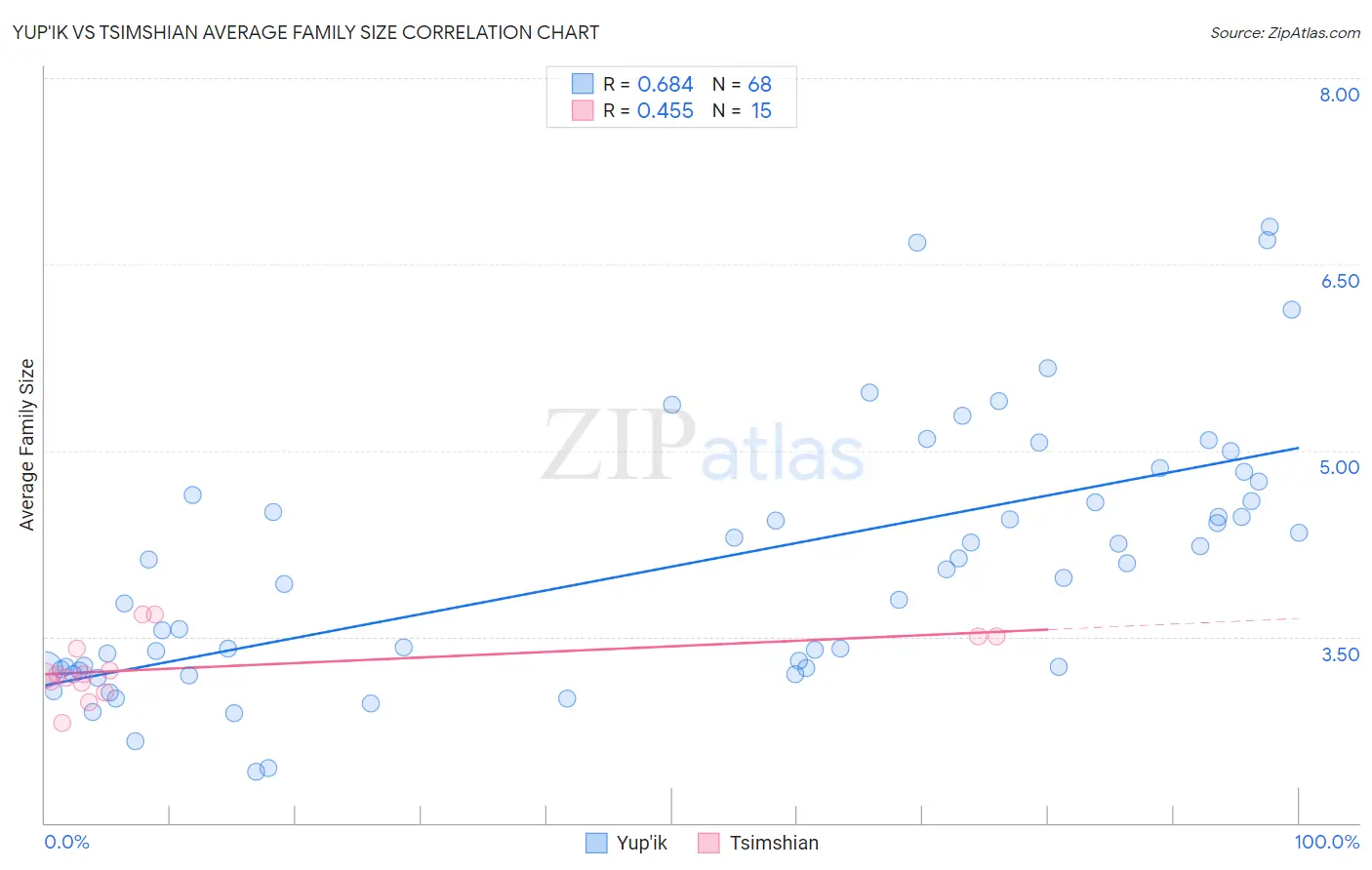Yup'ik vs Tsimshian Average Family Size
COMPARE
Yup'ik
Tsimshian
Average Family Size
Average Family Size Comparison
Yup'ik
Tsimshian
4.00
AVERAGE FAMILY SIZE
100/ 100
METRIC RATING
1st/ 347
METRIC RANK
3.25
AVERAGE FAMILY SIZE
80.2/ 100
METRIC RATING
144th/ 347
METRIC RANK
Yup'ik vs Tsimshian Average Family Size Correlation Chart
The statistical analysis conducted on geographies consisting of 39,956,738 people shows a significant positive correlation between the proportion of Yup'ik and average family size in the United States with a correlation coefficient (R) of 0.684 and weighted average of 4.00. Similarly, the statistical analysis conducted on geographies consisting of 15,626,544 people shows a moderate positive correlation between the proportion of Tsimshian and average family size in the United States with a correlation coefficient (R) of 0.455 and weighted average of 3.25, a difference of 23.0%.

Average Family Size Correlation Summary
| Measurement | Yup'ik | Tsimshian |
| Minimum | 2.41 | 2.80 |
| Maximum | 6.80 | 3.68 |
| Range | 4.39 | 0.88 |
| Mean | 4.07 | 3.26 |
| Median | 4.01 | 3.20 |
| Interquartile 25% (IQ1) | 3.25 | 3.13 |
| Interquartile 75% (IQ3) | 4.61 | 3.50 |
| Interquartile Range (IQR) | 1.37 | 0.37 |
| Standard Deviation (Sample) | 1.02 | 0.25 |
| Standard Deviation (Population) | 1.01 | 0.24 |
Similar Demographics by Average Family Size
Demographics Similar to Yup'ik by Average Family Size
In terms of average family size, the demographic groups most similar to Yup'ik are Crow (3.82, a difference of 4.5%), Pueblo (3.79, a difference of 5.3%), Pima (3.75, a difference of 6.7%), Navajo (3.65, a difference of 9.6%), and Arapaho (3.64, a difference of 9.9%).
| Demographics | Rating | Rank | Average Family Size |
| Yup'ik | 100 /100 | #1 | Exceptional 4.00 |
| Crow | 100 /100 | #2 | Exceptional 3.82 |
| Pueblo | 100 /100 | #3 | Exceptional 3.79 |
| Pima | 100 /100 | #4 | Exceptional 3.75 |
| Navajo | 100.0 /100 | #5 | Exceptional 3.65 |
| Arapaho | 100.0 /100 | #6 | Exceptional 3.64 |
| Inupiat | 100.0 /100 | #7 | Exceptional 3.63 |
| Immigrants | Yemen | 100.0 /100 | #8 | Exceptional 3.60 |
| Hopi | 100.0 /100 | #9 | Exceptional 3.60 |
| Spanish American Indians | 100.0 /100 | #10 | Exceptional 3.58 |
| Tohono O'odham | 100.0 /100 | #11 | Exceptional 3.53 |
| Immigrants | Mexico | 100.0 /100 | #12 | Exceptional 3.52 |
| Sioux | 100.0 /100 | #13 | Exceptional 3.52 |
| Immigrants | Central America | 100.0 /100 | #14 | Exceptional 3.49 |
| Tongans | 100.0 /100 | #15 | Exceptional 3.49 |
Demographics Similar to Tsimshian by Average Family Size
In terms of average family size, the demographic groups most similar to Tsimshian are Bhutanese (3.25, a difference of 0.020%), Liberian (3.25, a difference of 0.030%), Immigrants from Ethiopia (3.25, a difference of 0.040%), Subsaharan African (3.25, a difference of 0.040%), and Venezuelan (3.25, a difference of 0.040%).
| Demographics | Rating | Rank | Average Family Size |
| Immigrants | Middle Africa | 82.4 /100 | #137 | Excellent 3.25 |
| Cubans | 81.8 /100 | #138 | Excellent 3.25 |
| Immigrants | Ethiopia | 81.6 /100 | #139 | Excellent 3.25 |
| Sub-Saharan Africans | 81.6 /100 | #140 | Excellent 3.25 |
| Venezuelans | 81.4 /100 | #141 | Excellent 3.25 |
| Liberians | 81.2 /100 | #142 | Excellent 3.25 |
| Bhutanese | 81.0 /100 | #143 | Excellent 3.25 |
| Tsimshian | 80.2 /100 | #144 | Excellent 3.25 |
| Armenians | 78.2 /100 | #145 | Good 3.25 |
| Immigrants | Africa | 77.9 /100 | #146 | Good 3.25 |
| Immigrants | Jordan | 75.7 /100 | #147 | Good 3.24 |
| Blackfeet | 75.0 /100 | #148 | Good 3.24 |
| Assyrians/Chaldeans/Syriacs | 73.8 /100 | #149 | Good 3.24 |
| Indians (Asian) | 73.6 /100 | #150 | Good 3.24 |
| Jordanians | 73.5 /100 | #151 | Good 3.24 |